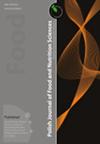绿茶中的铁、锌、铜、锰和铬,它们在提取物中的转移及元素含量与生物活性化合物的相关性
IF 2.3
4区 农林科学
Q3 FOOD SCIENCE & TECHNOLOGY
引用次数: 3
摘要
测定所选元素的转移量,铁(Fe)、(Zn)、(Cu)、锰(Mn)、铬(Cr)、茶的主要生物活性化合物是否转移。研究中使用了12种市售绿茶。采用电感耦合等离子体发射光谱(ICP-OES)对80%丙酮(v/v)得到的绿茶及其提取物中的元素含量进行了分析。采用反相高效液相色谱法(RP-HPLC)测定咖啡因、(-)-没食子儿茶素(EGC)、(-)-表儿茶素(EP)、(-)-没食子儿茶素没食子酸酯(EGCG)和(-)-表儿茶素没食子酸酯(ECG)的含量。绿茶中Mn的含量最高(711 ~ 1402µg/g),但其转移到提取物中的含量最低(0.269 ~ 0.646%)。茶中第二大元素铁的平均转移率为5.52%(115 ~ 725µg/g)。提取物中Mn和Fe含量分别为5.08 ~ 30.2µg/g和10.7 ~ 90.1µg/g。Zn、Cu和Cr的转移率分别为10.4、20.0和26.2%,导致其含量分别为5.03 ~ 12.6、1.93 ~ 13.8和0.128 ~ 2.03µg/g。结果表明,绿茶提取物中锌含量与EGCG、EGC、总黄酮-3-醇含量及(或)转移至提取物中,以及相同铁变量与EGC之间呈显著正相关,表明这些黄烷-3-醇可能正影响绿茶提取物中铁和锌的转移。反过来,在锰和铜的情况下发现了显著的负相关。未来的研究需要确定从绿茶到提取物的各种元素转移速率的原因。本文章由计算机程序翻译,如有差异,请以英文原文为准。
Iron, Zinc, Copper, Manganese and Chromium in Green Teas, Their Transfer to Extracts and Correlations between Contents of Elements and Bioactive Compounds
determine the of transfer of selected elements, , iron (Fe), (Zn), (Cu), manga (Mn), chromium (Cr), teas to investigate whether the main bioactive compounds of the extracts transfer. Twelve commercially available green teas were used in the study. The contents of elements in green teas and their extracts obtained with 80% acetone ( v/v ) were analysed by inductively coupled plasma optical emission spectroscopy (ICP-OES). High performance liquid chromatography in reverse phase (RP-HPLC) was used to determine contents of caffeine, (–)-epigallocatechin (EGC), (–)-epicatechin (EP), (–)-epigallocatechin gallate (EGCG), and (–)-epicatechin gallate (ECG). The element with the highest content in green teas was Mn (711–1402 µg/g), but its transfer to extracts was the lowest (0.269–0.646%). The mean Fe transfer, second abundant element in teas (115–725 µg/g), was 5.52%. The contents of Mn and Fe in extracts were 5.08–30.2 and 10.7–90.1 µg/g, respectively. Zn, Cu, and Cr were transferred with means of 10.4, 20.0, and 26.2%, respectively, which resulted in their contents in the extracts in the ranges of 5.03–12.6, 1.93–13.8, and 0.128–2.03 µg/g, respectively. The significant positive correlations of Zn content in extracts and/or transfer to extracts with EGCG, EGC and total flavan-3-ols as well as between the same Fe variables and EGC were determined, which suggested that these flavan-3-ols may positively affect the transfer of Fe and Zn from green tea to extracts. In turn, significant but negative correlations were found in the case of Mn and Cu. Future research is needed to identify the causes of the various transfer rate of elements from green teas to extracts.
求助全文
通过发布文献求助,成功后即可免费获取论文全文。
去求助
来源期刊

Polish Journal of Food and Nutrition Sciences
FOOD SCIENCE & TECHNOLOGY-
CiteScore
4.30
自引率
12.50%
发文量
25
审稿时长
20 weeks
期刊介绍:
The Polish Journal of Food and Nutrition Sciences publishes original, basic and applied papers, reviews and short communications on fundamental and applied food research in the following Sections:
-Food Technology:
Innovative technology of food development including biotechnological and microbiological aspects
Effects of processing on food composition and nutritional value
-Food Chemistry:
Bioactive constituents of foods
Chemistry relating to major and minor components of food
Analytical methods
-Food Quality and Functionality:
Sensory methodologies
Functional properties of food
Food physics
Quality, storage and safety of food
-Nutritional Research Section:
Nutritional studies relating to major and minor components of food (excluding works related to questionnaire
surveys)
-“News” section:
Announcements of congresses
Miscellanea
 求助内容:
求助内容: 应助结果提醒方式:
应助结果提醒方式:


